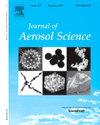Aerosol particle effective density of heated tobacco products measured with a tandem mass and mobility analyzer
IF 3.9
3区 环境科学与生态学
Q2 ENGINEERING, CHEMICAL
引用次数: 0
Abstract
To better understand the properties of “heat-not-burn” (HNB) tobacco products, the particle effective densities of aerosols emitted from 10 brands of HNB cigarettes are measured with a tandem mass and mobility analyzer, composed of a centrifugal particle mass analyzer (CPMA) and a scanning mobility particle sizer (SMPS). The aerosols are generated with a smoking machine and aged in a Teflon bag for 1 h prior to the measurement. The results show that the aerosol effective densities are independent of the particles’ mass, with their average values in the range of 1097–1443 kg/m3, which aligns with the spherical morphology identified by scanning electron microscope (SEM). However, the tobacco heating mode has a significant effect on the particle effective density, and the average values from the peripheral, needle and blade heating modes are measured at 1373, 1253 and 1183 kg/m3, respectively. The geometry of tobacco sticks such as their lengths and circumferences also has an impact on the particle effective density. Specifically, longer cigarette lengths and slimmer sticks produce particles with higher effective densities (∼5 %–20 % higher). Although previous studies have shown that the HNB cigarettes generate less harmful toxicants than the traditional combustion cigarettes, this work demonstrates no significant difference in their aerosol particle effective densities.
用串联质量和迁移率分析仪测定加热烟草制品的气溶胶粒子有效密度
为了更好地了解“热不燃”(HNB)烟草产品的特性,使用离心颗粒质量分析仪(CPMA)和扫描迁移率粒度仪(SMPS)组成的串联质量和迁移率分析仪(SMPS)测量了10个品牌HNB卷烟排放的气溶胶颗粒有效密度。在测量之前,气溶胶是用吸烟机产生的,并在聚四氟乙烯袋中老化1小时。结果表明:气溶胶有效密度与颗粒质量无关,其平均值在1097 ~ 1443 kg/m3之间,与扫描电镜(SEM)观测到的气溶胶球形形貌一致;烟叶加热方式对颗粒有效密度影响显著,外围加热、针叶加热和叶片加热方式的平均值分别为1373、1253和1183 kg/m3。烟叶的长度和周长等几何形状对烟叶颗粒的有效密度也有影响。具体而言,较长的卷烟长度和较细的卷烟杆产生的颗粒具有更高的有效密度(高出约5% - 20%)。虽然以前的研究表明,HNB香烟产生的有害毒物比传统燃烧香烟少,但这项工作表明,它们的气溶胶颗粒有效密度没有显著差异。
本文章由计算机程序翻译,如有差异,请以英文原文为准。
求助全文
约1分钟内获得全文
求助全文
来源期刊

Journal of Aerosol Science
环境科学-工程:化工
CiteScore
8.80
自引率
8.90%
发文量
127
审稿时长
35 days
期刊介绍:
Founded in 1970, the Journal of Aerosol Science considers itself the prime vehicle for the publication of original work as well as reviews related to fundamental and applied aerosol research, as well as aerosol instrumentation. Its content is directed at scientists working in engineering disciplines, as well as physics, chemistry, and environmental sciences.
The editors welcome submissions of papers describing recent experimental, numerical, and theoretical research related to the following topics:
1. Fundamental Aerosol Science.
2. Applied Aerosol Science.
3. Instrumentation & Measurement Methods.
 求助内容:
求助内容: 应助结果提醒方式:
应助结果提醒方式:


